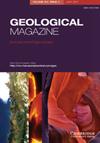The Sr, Nd, Pb and Hf isotopes and crystallization conditions of the middle Eocene Dağdibi Pluton in the eastern Sakarya Zone, Turkey
IF 2
3区 地球科学
Q3 GEOSCIENCES, MULTIDISCIPLINARY
引用次数: 0
Abstract
Abstract Magmatic activity in the Sakarya Zone, an important segment of the Alpine orogenic belt, continues intermittently from the middle Carboniferous to Miocene. In this study, we provide geochronological and geochemical data from the Dağdibi Pluton in the eastern Sakarya Zone to present some inferences on the source region and petrogenesis of the middle Eocene magmatism. U–Pb zircon geochronology from two granodiorite samples gives middle Eocene ages of 44.75 ± 0.92 and 45.01 ± 0.59 Ma. The pluton is mainly composed of K-feldspar, plagioclase, quartz, Mg-hornblende/actinolite, Fe–Ti oxides and small amounts of biotite, and secondary chlorite and epidote. Parental magma of the intrusive rocks has a high-K calc-alkaline affinity with metaluminous character. The oxygen fugacity values vary between −18 and −17. The rocks show slightly radiogenic 87Sr/86Sr(i) (0.704845–0.705726) ratios and ϵNdi values between −0.96 and +0.52. Pb–Pb isotope ratios are typical for those of the lower continental crust. ϵHf(i) values of the zircons range from 0.14 to 10.26. The geochemical and isotopic features of the pluton point to a parental magma derived from a depleted mantle that was metasomatized by fluids during previous subduction events. The volumetric abundances of the rock types are decreased as the silica content increase, implying that the fractional crystallization is the most important process during the formation of the present compositional range of the pluton. Amphibole, plagioclase and Fe–Ti oxides are the fractionated phases while K-feldspar is largely accumulated. In the light of the data presented above, slab breakoff is regarded as the geodynamic process responsible for the formation of the Dağdibi Pluton in the middle Eocene.土耳其萨卡里亚带东部始新世中期Dağdibi Pluton的Sr、Nd、Pb和Hf同位素及结晶条件
中石炭世至中新世,作为高寒造山带的重要一段,萨卡雅带岩浆活动断断续续。本文利用萨卡里亚东部Dağdibi岩体的年代学和地球化学资料,对中始新世岩浆活动的源区和成因进行了推测。两个花岗闪长岩样品的U-Pb锆石年代学结果显示,中始新世年龄分别为44.75±0.92和45.01±0.59 Ma。岩体主要由钾长石、斜长石、石英、镁角闪石/放光石、铁钛氧化物和少量黑云母、次生绿泥石和绿帘石组成。侵入岩母岩浆具有高钾钙碱性亲和性,具有成矿特征。氧逸度值在−18和−17之间变化。87Sr/86Sr(i)比值为0.704845 ~ 0.705726,ϵNdi值为- 0.96 ~ +0.52。Pb-Pb同位素比值是典型的下大陆地壳同位素比值。ϵHf(i)锆石值在0.14 ~ 10.26之间。该岩体的地球化学和同位素特征表明,其母岩浆来自于先前俯冲事件中被流体交代的枯竭地幔。岩石类型的体积丰度随石英含量的增加而减小,说明分馏结晶是形成岩体现今组成范围的最重要过程。角闪石、斜长石和铁钛氧化物是分馏相,钾长石则主要富集。根据上述资料,我们认为在始新世中期,板块断裂是造成Dağdibi岩体形成的地球动力学过程。
本文章由计算机程序翻译,如有差异,请以英文原文为准。
求助全文
约1分钟内获得全文
求助全文
来源期刊

Geological Magazine
地学-地球科学综合
CiteScore
4.70
自引率
0.00%
发文量
111
审稿时长
3 months
期刊介绍:
Geological Magazine, established in 1864, is one of the oldest and best-known periodicals in earth sciences. It publishes original scientific papers covering the complete spectrum of geological topics, with high quality illustrations. Its worldwide circulation and high production values, combined with Rapid Communications and Book Review sections keep the journal at the forefront of the field.
This journal is included in the Cambridge Journals open access initiative, Cambridge Open Option.
 求助内容:
求助内容: 应助结果提醒方式:
应助结果提醒方式:


